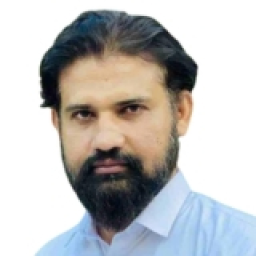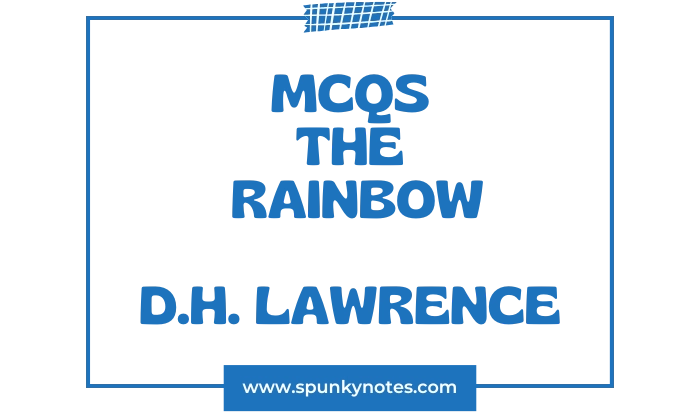

Estimated Reading Time: 18 min
The Rainbow MCQs
1. Where did the Brangwens live for generations?
A. Shelly Hall
B. Ilkeston Vicarage
C. Marsh Farm
D. The Black Horse
2. What structure did the Brangwen men see in the empty sky when they lifted their heads from work?
A. A colliery headstock
B. Nottingham Castle
C. A church-tower at Ilkeston
D. A cathedral spire
3. The Brangwen men are described as facing inwards to what kind of life?
A. The spoken world beyond
B. The teeming life of creation
C. Cities and governments
D. Outward scope and freedom
4. What did the Brangwen women look out towards?
A. The fertile soil
B. The heated, blind intercourse of farm-life
C. The spoken world beyond
D. The grain furrow
5. What did the wife believe the Vicar possessed that raised him above common men?
A. Money
B. Position
C. Power over Tom Brangwen
D. Knowledge
6. Who was the lady of Shelly Hall who served as the “living dream” for the women of Cossethay?
A. Mrs. Brangwen
B. Mrs. Hardy
C. Mrs. Lensky
D. Alice Brangwen
7. What kind of emotion moved Tom Brangwen beyond all calculation when the teacher read Tennyson’s “Ulysses”?
A. Amusement
B. Betrayed emotion
C. Violent repulsion
D. Rage and incompetence
8. What nationality was the lady Tom Brangwen married?
A. German
B. Russian
C. Polish
D. Venetian
9. What was the name of the Polish lady’s little girl?
A. Effie
B. Anna
C. Alice
D. Gudrun
10. What was the Polish lady’s first request when she came knocking at the Marsh Farm door?
A. A room to rent
B. A pound of butter
C. An interview with the vicar
D. To see Anna
11. In the long February nights, while tending the ewes in labour, Tom realized that without Lydia, he was what?
A. Masterful
B. Complete
C. A fragment
D. A thing of power
12. What flowers did Brangwen bring when he proposed to Mrs. Lensky?
A. Roses
B. Lilies
C. Daffodils
D. Snowdrops
13. After Lensky’s death, what became Lydia’s desire, though she could not fulfill it?
A. To return to Poland
B. To seek satisfaction in dread
C. To marry Brangwen
D. To become a refugee again
14. At the wedding, what did Brangwen stare at, which glowed intensely in the church?
A. The altar cloth
B. The east window
C. His wife’s bonnet
D. The vicar’s face
15. Tom Brangwen argued that a married couple makes what, since an Angel cannot be less than a human being?
A. One Angel
B. Two souls
C. Heaven
D. A legion
16. Tom Brangwen eventually had to learn the bitter lesson to subdue himself and take what?
A. Full control
B. Less than he wanted
C. More freedom
D. Another wife
17. What happened to Tom Brangwen (the elder) during a heavy flood at the Marsh Farm?
A. He escaped on his horse
B. He was found drinking
C. He was pushed past the house drowning
D. He safely reached the stable
18. Who was the Polish exile and Vicar who was Anna’s mother’s friend?
A. Lensky
B. Baron Skrebensky
C. Lord William
D. Mr. Gladstone
19. Will Brangwen was primarily interested in church architecture and was influenced by whom?
A. Shelley
B. Browning
C. Ruskin
D. Tennyson
20. What mythological figures was Will carving for a church panel?
A. The Virgin Mary
B. Adam and Eve
C. St. George and the Dragon
D. Penelope and Ulysses
21. Where did Will and Anna meet one moonlit night to put up sheaves?
A. In the Marsh yard
B. In the open stubble field
C. In the vicarage garden
D. In the slaughter-house
22. What structure stood next to the cottage Tom Brangwen rented for the young couple?
A. A factory
B. The Marsh Farm
C. The church
D. The Black Swan Inn
23. Anna became hostile because Will seemed in correspondence with what image in the church window?
A. The Virgin Mary
B. The lamb with the flag
C. The cross
D. St. George
24. What structure did Will Brangwen buy a book about in Nottingham, finding great satisfaction?
A. St. Paul’s Cathedral
B. Lincoln Cathedral
C. Bamberg Cathedral
D. St. Nicholas
25. Anna jeered at Will’s carving, saying Eve was like what size object?
A. A giant
B. A doll/marionette
C. A lion
D. A flower
26. What saved Anna from being swept away by the tide of passion in the cathedral?
A. The altar
B. Her mother-of-pearl rosary
C. The organ music
D. Sly little faces carved in stone
27. Anna’s soul was in bliss over the baby. Before this baby was ten months old, what was she again?
A. Trying to leave Will
B. Looking for work
C. With child
D. Going to London
28. The second child born to Anna and Will was a girl named what?
A. Ursula
B. Catherine
C. Gudrun
D. Theresa
29. Who was Ursula’s chief friend at the age of eight, who saw the world in a great, hushed space?
A. Maggie Schofield
B. Her mother Anna
C. Her Uncle Tom
D. Her grandmother Lydia
30. What gave Ursula a deep, joyous thrill, leading her to feel “fate on either side of her terrible”?
A. Her education
B. Her Polish antecedents
C. Her mother’s love
D. Her father’s gifts
31. When Ursula saw a Rubens picture of naked babies, what was the title that made her shudder?
A. The Nativity
B. Fecundity
C. The Judgment
D. Adam and Eve
32. What did Ursula hate most about the evangelical teachings she encountered?
A. The rejection of the Pope
B. The insistence on the humanity of Christ
C. The mention of salvation
D. The emphasis on rules
33. Ursula’s soul was stirred by the Biblical passage about the Sons of God marrying whom?
A. The daughters of Zion
B. The daughters of men
C. The daughters of Israel
D. The daughters of Noah
34. Who was the first person Ursula encountered as a real, living person outside her parents’ orbit?
A. Will Brangwen
B. Baron Skrebensky
C. Mr. Harby
D. Tilly
35. What did the headmaster’s primary drive in life, according to Ursula’s perception?
A. To educate the children
B. To hold blind authority over the school
C. To earn good wages
D. To reform the system
36. Which boy did Ursula finally seize and drag to the front of the class, resulting in a physical altercation?
A. Hill
B. Wright
C. Williams
D. Letts
37. After being “broken in” to teaching, Ursula realized her job was a prison where her chaotic soul became what?
A. More sensitive
B. Hard and independent
C. Completely corrupted
D. Passionate and free
38. What was Ursula studying for during her first year of college?
A. Final Arts
B. Intermediate Arts
C. Matriculation
D. Pure Botany
39. By her final year, Ursula viewed college as a little apprentice-shop where one was equipped for what purpose?
A. Making money
B. Spiritual growth
C. Self-realization
D. True learning
40. Who was Tom Brangwen’s (Ursula’s Uncle) real mistress, according to Ursula’s critical perception?
A. Winifred Inger
B. The pit/machine
C. His wife
D. Ursula
41. Anton Skrebensky’s views on duty required every man to give himself to support what institution?
A. The church
B. The individual
C. The state
D. The aristocracy
42. When Ursula told Anton she didn’t want to marry him, how did he react?
A. He became abusive
B. He cried uncontrollably, noiselessly
C. He left immediately and angrily
D. He laughed nervously
43. Ursula failed her final examination, which resulted in her not receiving what?
A. Her certificate
B. Her degree
C. A teaching post
D. A promotion
44. What was the one thing Ursula knew subconsciously about her upcoming marriage date?
A. She would be late
B. She would never sail for India
C. She would fail her examination
D. She would marry the Colonel’s daughter
45. What did Anton say to Ursula on the sand-dunes that caused her to break off the engagement?
A. He told her he was leaving
B. He said, “I have no soul”
C. He proposed to her
D. He was silent, waiting for the moon to conquer her
46. What action did Anton take immediately after breaking up with Ursula?
A. He returned to his old job
B. He married his Colonel’s daughter
C. He drank himself to oblivion
D. He wrote a long letter to Ursula
47. What immediate realization came to Ursula weeks after the breakup?
A. She had failed her exam
B. She was with child
C. She missed Anton terribly
D. She loved teaching
48. What did Ursula try to avoid lifting her face to as she walked in the wilderness track during the rain?
A. The church tower
B. The colliery
C. Some horses looming
D. The turbulent sky
49. In her delirium, what did Ursula realize was the thing that bound her to Skrebensky and his world?
A. Her love
B. Financial necessity
C. The child
D. The desire for security
50. In her final moment of delirium, what did Ursula compare herself to, bursting forth from an unreality?
A. A soaring bird
B. A stone at rest
C. A ship sailing free
D. An acorn kernel thrusting forth a shoot
Brief Overview
The Rainbow is a novel by D. H. Lawrence. It tells the story of three generations of the Brangwen family, who live on a farm in the English countryside. The novel follows their lives and relationships as England changes from a farming country to a modern industrial one.
The story begins with Tom Brangwen, a farmer. He marries a Polish widow named Lydia. Their marriage is a struggle, but they eventually find a deep, quiet connection. This first part establishes the family’s deep roots in the land.
The second generation focuses on Tom’s step-daughter, Anna, and his nephew, Will Brangwen. They have a very passionate and stormy marriage. They are bound together by a powerful physical love but also fight constantly, as Anna struggles for her own independence from the controlling Will.
The final, and largest, part of the book is about Ursula, the eldest daughter of Anna and Will. Ursula is intelligent, modern, and desperate to escape her family’s limited life. She goes to college, becomes a teacher, and has a difficult, failed love affair with a soldier named Anton Skrebensky.
Ursula struggles to find her own identity as a modern woman. She does not want to just get married and have children. The novel ends after she has a breakdown, but she sees a vision of a rainbow. The rainbow represents hope and a new kind of life that she might be able to find.


